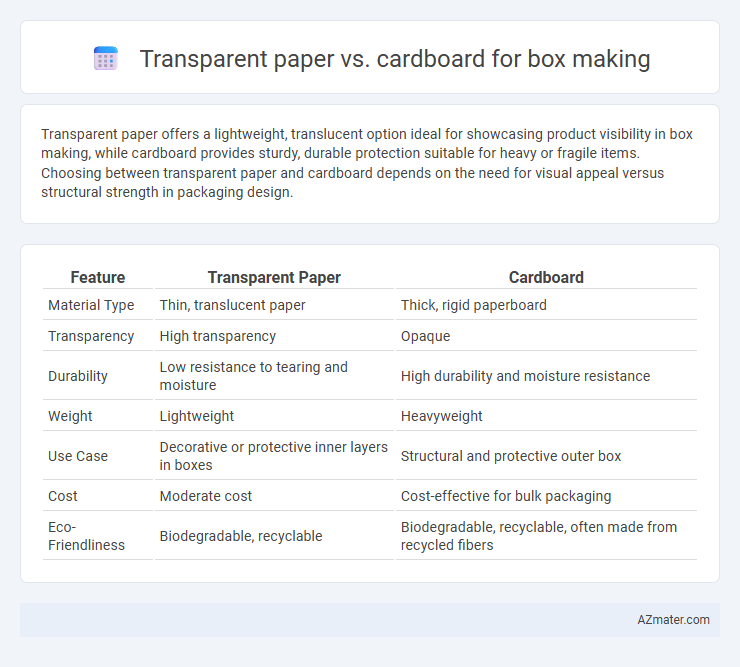Transparent paper offers a lightweight, translucent option ideal for showcasing product visibility in box making, while cardboard provides sturdy, durable protection suitable for heavy or fragile items. Choosing between transparent paper and cardboard depends on the need for visual appeal versus structural strength in packaging design.
Table of Comparison
| Feature | Transparent Paper | Cardboard |
|---|---|---|
| Material Type | Thin, translucent paper | Thick, rigid paperboard |
| Transparency | High transparency | Opaque |
| Durability | Low resistance to tearing and moisture | High durability and moisture resistance |
| Weight | Lightweight | Heavyweight |
| Use Case | Decorative or protective inner layers in boxes | Structural and protective outer box |
| Cost | Moderate cost | Cost-effective for bulk packaging |
| Eco-Friendliness | Biodegradable, recyclable | Biodegradable, recyclable, often made from recycled fibers |
Introduction: Choosing the Right Material for Box Making
Transparent paper offers a lightweight, visually appealing option for packaging that highlights product visibility, ideal for retail displays and gift boxes. Cardboard provides superior durability and structural strength, making it suitable for heavy or fragile items requiring protection during shipping and handling. Selecting between transparent paper and cardboard depends on the balance between aesthetic appeal and functional sturdiness needed for the box application.
Key Properties of Transparent Paper
Transparent paper offers high translucency, enabling visibility of contents while protecting items from dust and moisture, which is ideal for packaging delicate goods. Its lightweight and flexible nature allows easy folding and customization, unlike rigid cardboard that offers structural strength but limits design flexibility. Transparency combined with moderate tear resistance makes it suitable for packaging where visual appeal and protection are both priorities over durability and rigidity provided by cardboard.
Key Properties of Cardboard
Cardboard used for box making boasts high durability, excellent rigidity, and superior impact resistance, making it ideal for protecting contents during shipping and handling. Its thickness and structural integrity allow for easy customization and printing, enhancing brand presentation and product visibility. Cardboard is also eco-friendly, being recyclable and often made from recycled materials, which supports sustainable packaging solutions.
Durability Comparison: Transparent Paper vs Cardboard
Cardboard offers superior durability compared to transparent paper, with its thick, rigid structure providing enhanced resistance to tearing, bending, and impact. Transparent paper, while visually appealing and lightweight, lacks the strength and protective qualities necessary for long-term or heavy-duty box making. For packaging that demands structural integrity and durability, cardboard remains the preferred material due to its robustness and ability to withstand physical stress.
Aesthetic Appeal and Design Flexibility
Transparent paper offers a sleek, modern aesthetic that enhances product visibility, making it ideal for packaging that aims to showcase contents while maintaining lightweight structure. Cardboard provides robust design flexibility with its ability to be easily printed, die-cut, and embossed, allowing for intricate branding and durable protection. The choice between transparent paper and cardboard depends on whether the priority is visual appeal through clarity or customizable, sturdy design elements.
Protection and Security for Packaging
Transparent paper offers limited protection and security for packaging due to its thin, lightweight nature, making it prone to tearing and less effective against moisture and external damage. Cardboard, with its rigid structure and cushioning properties, provides superior protection by absorbing shocks and preventing deformation during transit. For secure packaging, cardboard is preferred as it ensures durability and safeguards contents from physical impacts and environmental hazards.
Cost-Effectiveness and Availability
Transparent paper offers a cost-effective solution for box making due to its lower material expense and lightweight nature, which reduces shipping costs. Cardboard, while generally more expensive, provides superior durability and structural strength, making it ideal for heavier or protective packaging needs. Availability-wise, cardboard is widely accessible in various thicknesses and types, whereas transparent paper may have limited supply and variations depending on specialized manufacturers.
Environmental Impact and Sustainability
Transparent paper offers superior biodegradability and recyclability compared to cardboard, largely due to its thinner composition and minimal ink usage, reducing landfill waste and energy consumption in processing. Cardboard, while durable and recyclable, often requires more resources in production, including significant water and energy inputs, and may contain coatings or adhesives that hinder full recyclability. Choosing transparent paper for box making supports a lower carbon footprint and promotes circular economy principles through easier composting and repulping processes.
Ideal Uses: When to Choose Transparent Paper or Cardboard
Transparent paper is ideal for packaging products that require visibility, such as gift wrapping, floral arrangements, and delicate items, allowing consumers to see the contents clearly. Cardboard is better suited for sturdy packaging needs like shipping boxes, storage containers, and product displays where protection and structural integrity are essential. Choose transparent paper for lightweight, decorative packaging and cardboard for durable, protective, and stackable box construction.
Final Verdict: Which Material Wins for Box Making?
Transparent paper offers excellent visibility for product display and a lightweight, eco-friendly option, but lacks durability and structural strength. Cardboard provides superior protection, sturdiness, and cost-effectiveness, making it ideal for shipping and heavy-duty packaging purposes. For box making, cardboard wins due to its resilience, versatility, and ability to safeguard contents during transit.

Infographic: Transparent paper vs Cardboard for Box making
 azmater.com
azmater.com